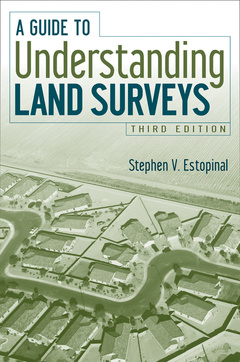Description
A guide to understanding land surveys, 3rd edition
Author: ESTOPINAL Stephen V.
Language: English
Approximative price 110.92 €
Subject to availability at the publisher.
Add to cart· Paperback
Description
/li>Contents
/li>Readership
/li>
1 PURPOSE OF THE BOOK.
2 REAL PROPERTY ON A ROUND PLANET.
2.1. Ownership.
2.2. Title.
2.3. Boundaries.
2.4. Deed.
2.5. Identifying Boundaries.
2.6. Corners.
3 GEOMETRY.
3.1. Plane Geometry.
3.2. Land Point.
3.3. Land Line.
3.4. Straight Land Line.
3.5. Plumb Line.
3.6. Level.
3.7. Land Distances.
3.8. Elevation.
3.9. Land Area.
3.10. Horizontal Angles.
3.11. Vertical Angles.
3.12. Degrees, Minutes, and Seconds.
3.13. Maps or Plats.
4 DEFINING NORTH.
4.1. True North.
4.2. Astronomic North.
4.3. Magnetic North.
4.4. Assumed North.
4.5. Grid North.
4.6. Directions.
4.7. Azimuths.
4.8. Bearings.
5 PROJECTION SYSTEMS.
5.1. Projectionless Maps.
5.2. Tangent Plane Projections.
5.3. Advantages of Tangent Plane Systems.
5.4. Disadvantages of Tangent Plane Systems.
5.5. State Plane Projections.
5.6. Advantages of State Plane Projections.
5.7. Disadvantages of the State Plane Projection.
6 FUNDAMENTALS OF MEASUREMENTS.
6.1. Accuracy and Precision.
6.2. Implied Precision.
6.3. Errors.
6.4. All Measurements Include Errors.
6.5. Reduction of Errors.
6.6. Development of Standard Procedures.
6.7. Colonial Period.
6.8. Post Civil War Period.
6.9. Beginning of the Modern Period.
7 LAND RECORD SYSTEMS.
7.1. Metes and Bounds System.
7.2. U.S. Public Land System (USPLS).
7.3. Platted Subdivision or Urban Systems.
8 THE GLOBAL POSITIONING SYSTEM (GPS).
8.1. Overview.
8.2. Fundamentals.
8.3. GPS and Land Surveys.
8.4. CORS Networks.
8.5. Practical Application.
8.6. Strengths.
8.7. Weaknesses.
8.8. Coping with Reality.
9 THE GEOGRAPHIC INFORMATION SYSTEM (GIS) REVOLUTION.
9.1. Building a Foundation.
9.2. Sources of Information.
9.3. System Maintenance.
9.4. Potential Users.
9.5. Potential for Misapplication.
10 BOUNDARY RECOVERY.
10.1. Rules of Evidence.
10.2. Sources of Evidence.
10.3. Office Procedure.
10.4. Field Procedure.
10.5. Rendering a Decision.
10.6. USPLS Boundary Recovery.
10.7. Metes and Bounds Boundary Recovery.
10.8. Platted Subdivision Boundary Recovery.
11 EVALUATING SURVEY PLATS.
11.1. Plat Evaluation Checklist.
11.2. Determining the Land Record System Used.
11.3. Determining the Map Projection Used.
11.4. Evaluating the Age of the Survey.
11.5. Determining the Purpose of the Survey.
11.6. Examining the Survey for Gross Discrepancies.
11.7. North Arrow.
11.8. Legal Description.
11.9. Date of the Survey.
11.10. Name of the Surveyor.
11.11. Signature and Seal.
11.12. Adjoining Properties.
11.13. Dimensions of All Sides.
11.14. Bearing or Angles.
11.15. Name of Client, Purpose of Survey.
11.16. Certification.
11.17. Limiting Words or Phrases.
11.18. Area.
11.19. Scale.
11.20. Comparing the Survey Plat with the Deed.
11.21. Examining the Survey Plat for Easements.
11.22. Examining the Survey Plat for Encroachments.
11.23....




